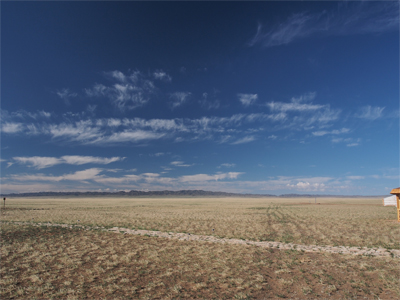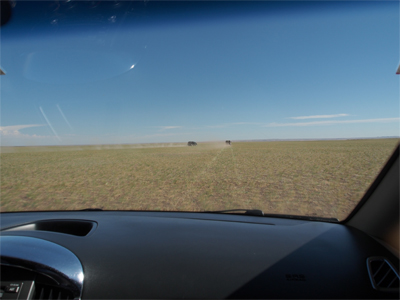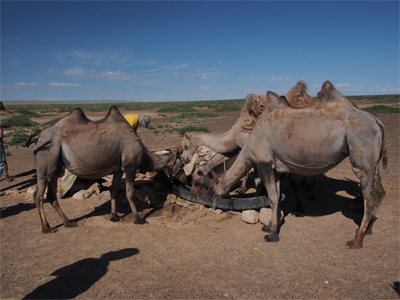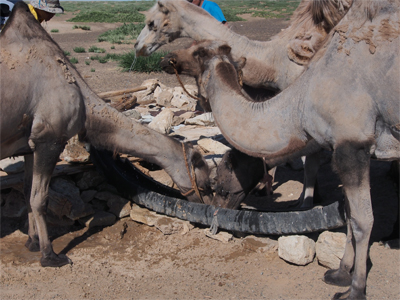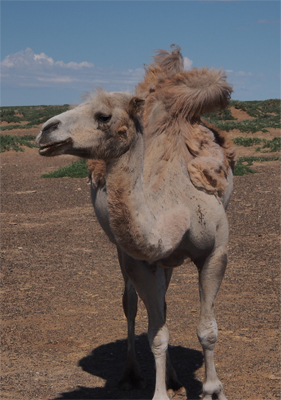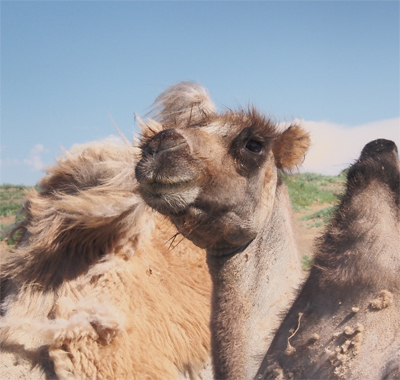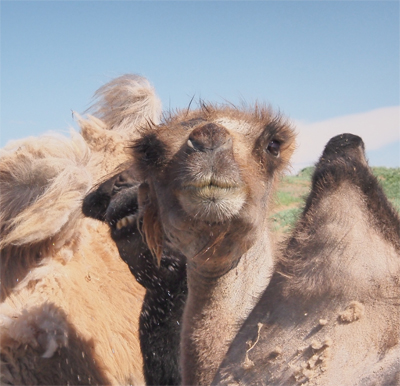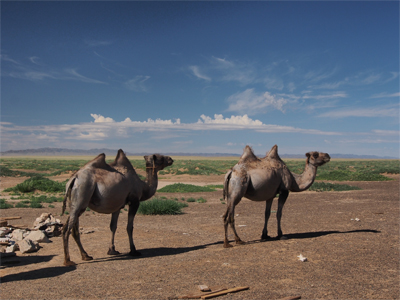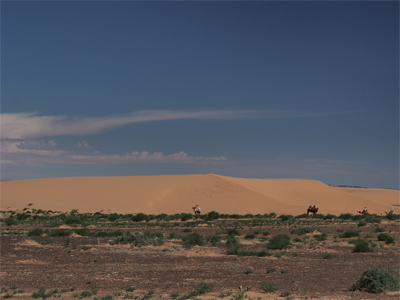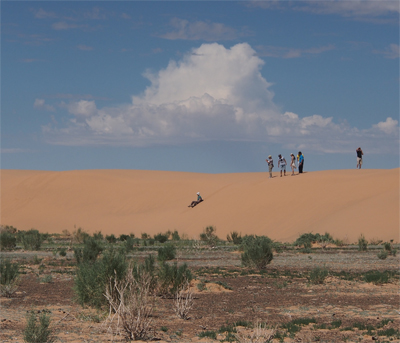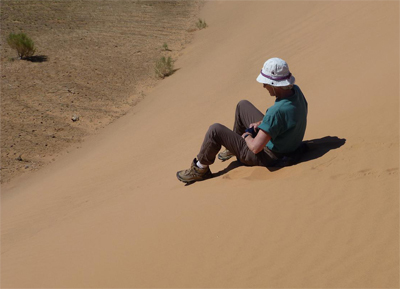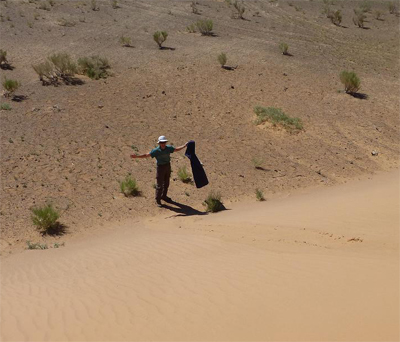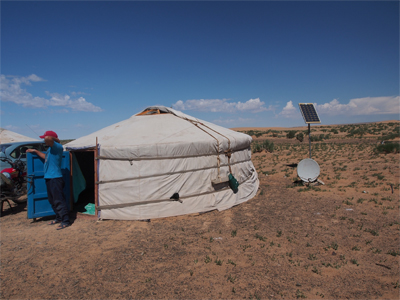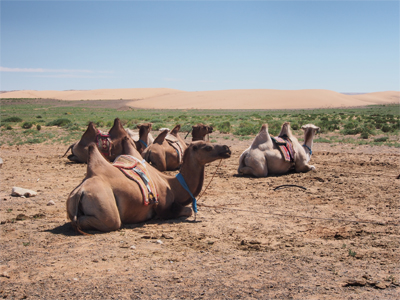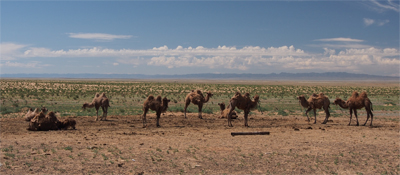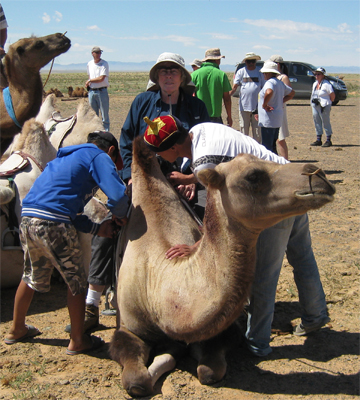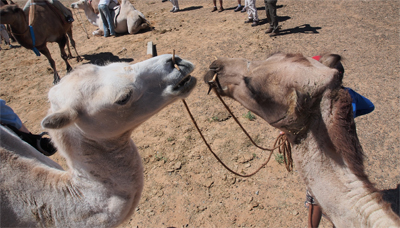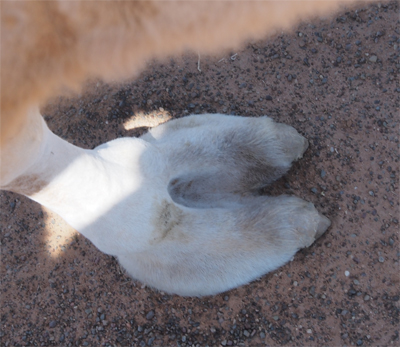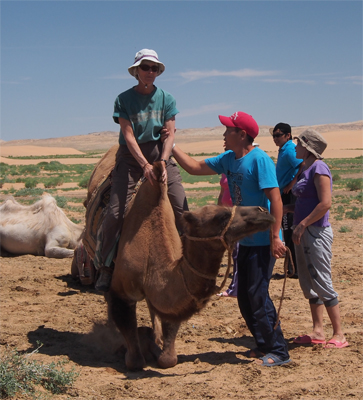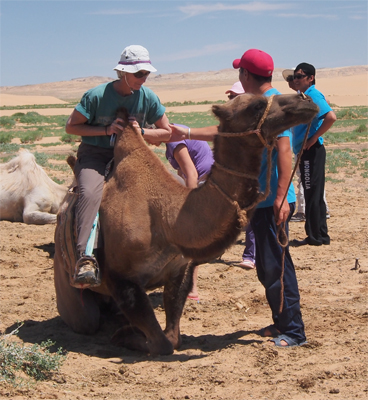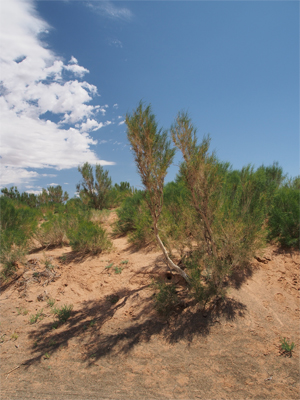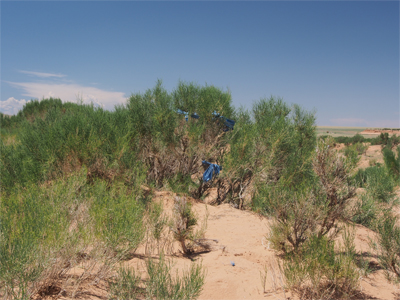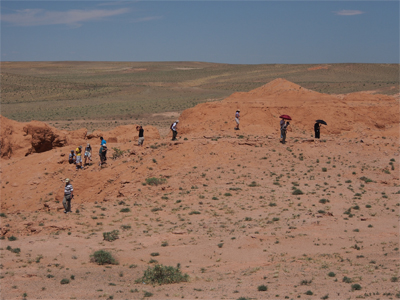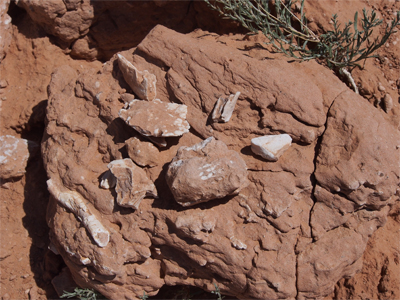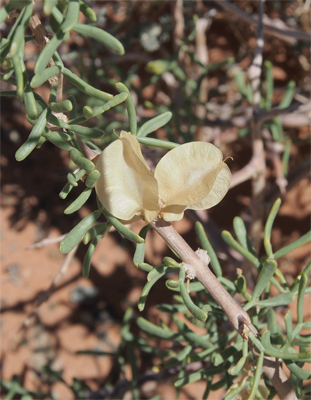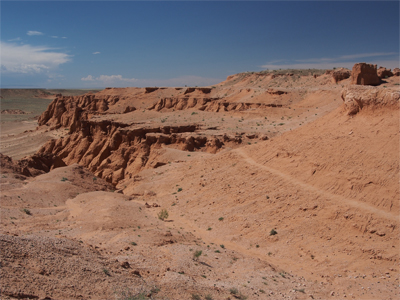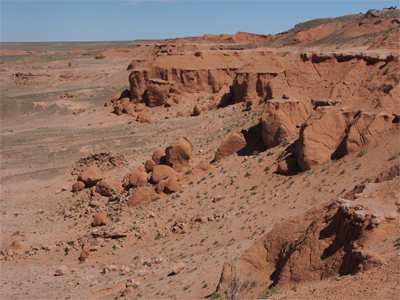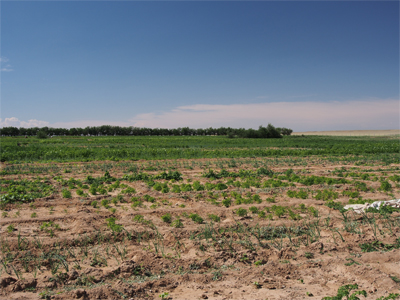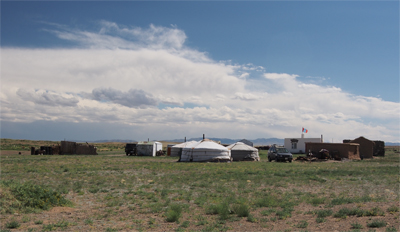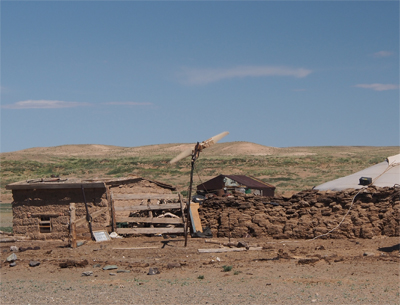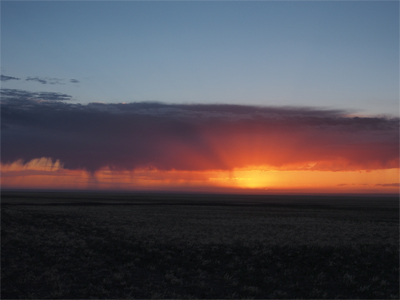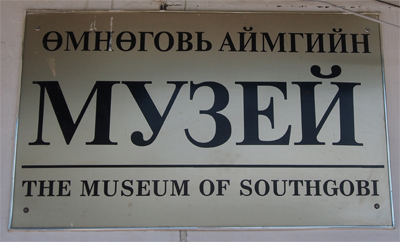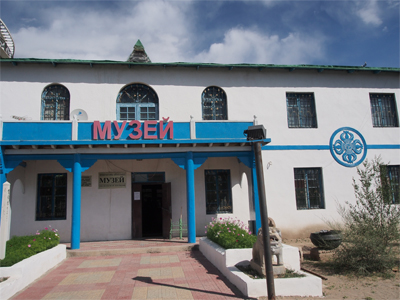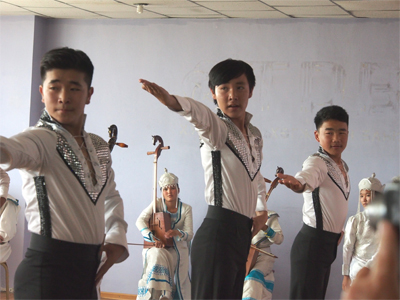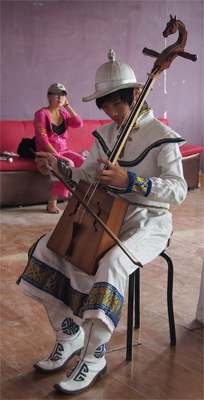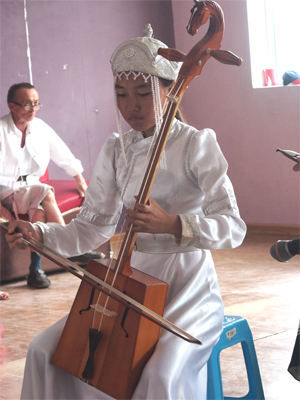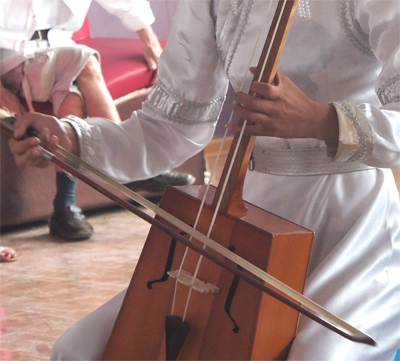Thurs., 7/4/13 - Independence Day in the Gobi Desert
Today we drove northeast to see several more of the 33 different eco systems here in the Gobi. We stopped at another water hole where five camels were waiting for someone to come along and pull up water using a rubber pail on a stick and pour it into an open tire tread. These are the two-humped Bactrian camels who can drink 40 liters of water at a time, much of which is stored in the fat in their humps. They can go 40 days with out drinking again, if necessary.
"Road" across the steppe |
Driving across the steppe - whoever gets there first has the right-of-way!
|
Bactrian camels at the water hole
|
Bactrian camels at the water hole |
Camel with a hump problem |
This guy was so cute!
|
Camels and sky and clouds
|
We drove on to small sand dunes in the Moltsog Els region. Only about 5% of the Gobi is pure sand and the biggest dunes are 150 kilometers further north. We walked on the dunes, looked at the mouse and bird tracks, and enjoyed the scenery for miles around. Here the dunes are confined to a small area but move with the wind, ever changing their form and location. Gale tried to slide down a steep dune on a poncho but the sand was too dense to slide on.
|
Gobi Desert dunes
|
Group walking up the dune |
Gobi Desert dunes |
Our "we were there" picture in the Gobi Desert
|
Gobi Desert dunes
|
Gobi Desert dunes and a disappearing road |
Gale attempting to slide down the dune
|
Gale attempting to slide down the dune |
At the bottom of the dune
|
Next we visited a nearby nomad family who herds about 50 camels. We sat in their ger and were served fermented camel milk tea. It tasted like soupy sour cream. We also had the opportunity to try their fry bread and camel milk curds. We took polite samples. The family lives off of their camels - milk, cheese, hides, hair/wool - and they sell handmade crafts to tourists. They also give camel rides to tourists. We rode the males because the females are used for breeding and milk. We each got on a camel (with padded "saddles" and stirrups) and were led by mother, father, and three sons ages 7, 9, and 13. We walked out to the dunes and posed for pictures. The Bactrian camel is much easier to ride than the Dromedary (one hump). You can hang on to the front hump and sitting between the humps is much more secure than balancing on the top of one hump. Riding either is far better/easier than riding a horse - of course, I have never been on a trotting or running camel.
|
Ger of the camel herder with satellite dish and solar panel
|
Waiting for us to get on |
This year's baby camels |
Stirrup adjustment
|
Ready to go
|
"And what do you think about your passenger?" |
Really interesting feet
|
Gale up and riding |
Time to get down - front end first
|
Then the back end and you are safely down |
Not far from the camel herder, we got out of the SUVs to wander in a Saxaul forest. This small tree is endemic to the Gobi and looks like Mormon tea bushes. The roots are one to two meters deep and can grow for hundreds of years. The wood is hard and burns like coal.
|
|
Saxaul forest
|
Saxaul forest |
Another eco system is the red clay and sandstone formations of the Flaming Cliffs. The area looks like the formations in Southern Utah and Bryce Canyon. In the 1920's American paleontologist Roy Chapman Andrews found a nest of dinosaur eggs and other fossils here. We wandered a little and looked for fossils. Fragments of bone are all over and not very hard to find. There were as many as 60 species of dinosaurs in the Gobi 60 to 70 million years ago. The Gobi was a sea until the Himalayas rose up. The sea
drained away and it became a desert.
|
Group looking for Dinosaur fossils |
Dinosaur fossils |
Interesting plant but don't know what it is
|
Flaming Cliffs
|
Flaming Cliffs |
On the way back to camp we stopped at a vegetable farm at an oasis that is tended by several families. They have fruit trees and grow potatoes, cabbage, watermelon, onions, and pumpkins. They water it by hand and use only a horse and plow to work the soil.
|
Vegetable "garden"
|
Nomad farmers' gers |
Power from the wind
|
It was hot today but the breeze made it bearable. We had showers and leisure time before dinner. Our chef made us a frosted layer cake to celebrate the Birth of our Nation and our meal was American pizza! At 9:30 we had a bonfire in lieu of fireworks. The staff sang to us and we sang to them. Happy July Fourth! Fri., 7/5/13 - Gobi to Dalanzadgad to Ulaanbaatar
|
|
Sunrise over the steppe
|
|
Museum of the South Gobi
|
Camel Museum |
We went back to the Crown Restaurant for "lunch on our own." At least it was a place to sit for two hours. After lunch Lucky arranged a special performance by a children's morin khuur (the horse head fiddle) and dance group. About 20 girls and boys were dressed in white traditional clothes and began to play for us in their auditorium when all the electricity went out. This is a normal occurrence here in DZ and in our camps. The children finished that piece in the pitch black without even blinking and then we all moved to the dance studio upstairs that had light from a wall of windows. The ensemble was formed three years ago and they play the traditional two-string fiddle, holding it between their knees like a small cello. The "male" string is played with the fingers pushing down on the throat but the "female" string is played by pushing the string sideways with the pinkie finger under the male string to reach the far string. The music was interspersed by a twelve-member (six boys and six girls) youth dance group that was formed ten months ago and has already won several competitions. Lucky has done an outstanding job finding us things to do when so many of our plane flights have been delayed.
|
Children's Morin Khuur (Horse Head Fiddle) and Dance group |
Children's Morin Khuur (Horse Head Fiddle) and Dance group |
The dancers
|
The dancers |
Playing the Morin Khuur
|
Playing the Morin Khuur
|
The "male" string is played with the fingers pushing down on the throat but the "female" string is played by pushing the string sideways with the pinkie finger under the male string to reach the far string. |
We went out to the airport again and waited. Nine hours delayed, we finally got on the plane and flew through turbulence to UB. We did get into UB for an 8:30 PM Farewell Dinner at the fancy Chinggis Khan Hotel. We were all too tired to enjoy it.
Sat., 7/6/13 - Ulaanbaatar to Beijing
We got up at 6 AM, got to the UB airport in good time, and the flight went smoothly enough. We found that the UB airport had three small souvenir shops. I finally found a spoon ($8), Bonnie found a small size real horse head fiddle, and Suzanne found two T-shirts. The three of us were happy.
We got to Beijing and our local guide/transfer rep took several of us to a great local restaurant three blocks from our hotel. Seven of us ordered six dishes with her help, five had beers or water, and our bill was 175 Yuan. That came out to $4.05 per person and the food was great!
Sun., 7/7/13 - Beijing to Los Angeles to Denver
This was a very long day. We left for the airport at 10 AM after a hotel buffet breakfast. We were supposed to fly out at 2 PM but the flight was delayed until 4:45, even though the plane was sitting there and the crew was sitting in the waiting area with us.
The flight from Beijing to Los Angeles was twelve hours, all in daylight and not easy to sleep. Instead of four hours in LAX to go through passport control, customs, recheck our luggage, and transfer from terminal 2 to terminal 7, we only had one hour. We hustled and were lucky to get to our gate, as the United flight to Denver was already half boarded.
By the time we got to our car in Denver, we had been traveling for 27 hours and had relived 14 hours of the time zone adjustment. We had a Subway sandwich and a Starbucks mocha on the way home - yay! for American fast food - and got in the house by 8:30 PM. We went straight to bed.
This trip was very interesting and unlike any of our other travels. China is much more ready for tourism than Mongolia is but Mongolia will probably change rapidly as solar panels, satellite dishes, and cell phones are very common, even among the nomadic people. At least we saw more western toilets in Mongolian cities than we did in China. Our favorite parts of the trip were the Stone Forest, the cultural performance and the food in China, and the terrain of all of Mongolia, especially the steppe and the Gobi Desert. The people we visited were all friendly and welcoming, but it is always good to be home again
